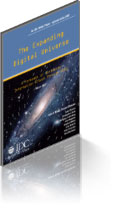Henry Jenkins, the Director of the Comparative Media Studies Program at the Massachusetts Institute of Technology has written a whitepaper, Confronting the Challenges of Participatory Culture: Media Education for the 21st Century, for the MacArthur Foundation that talks about the challenges of dealing with students who are (or want to be) participating in creating culture. (See my previous entry for a link to a presentation by Jenkins.) Joan Lippincott from the Coalition for Networked Information gave a talk today about how we should think about the library, learning, and space for these NetGen students who are used to the participatory culture of the web. To summarize her discussion of the differences between us and the Net Generation based partly on Jenkins:
- We tend to do things in serial (first this task and then that) whole the NetGen multitask.
- We (especially in the Humanities) value privacy and solitary work while the NetGen like to work in teams.
- We tend to value linear text while they value hyperlinked visual multimedia.
- We value critical thinking while they value creative production.
Joan goes on to argue that to reach the Net Generation Libraries need to rethink their services and spaces. She showed images of new spaces and discussed some of what she has written about in Linking the Information Commons to Learning which is part of a book from EDUCAUSE, Learning Spaces. Two things stuck me:
- Lack of Books. In most of the pictures shown of information commons there were no books! This certainly isn’t true when you look at the workstations of most students or faculty in their own spaces where books, papers, and computer are “mashed” together. Why then are information commons being set up apart from the books and periodicals? One wonders why libraries are building spaces that look more like what computing services should set up. Is it politics – libraries are doing what campus computing services failed to do? Joan, rightly I think, answered that these spaces are/should be set up in collaboration with people with technical skill (from computing) and that the idea is to connect students to content whether digital or print. Books should be there too or be at hand.
- Lack of Faculty Coordination. While these spaces are popular with students (see Henning’s Final Report on a survey of learning commons), the deeper problem is integration into the curriculum. Individual faculty may take advantage of the changing services and spaces of the library, but I haven’t seen the deep coordination that sees courses across the curriculum changed. Faculty assume the library is a service unit that supports their teaching by having books on reserve. We don’t think of the library as a living space where students are talking through our assignments, collaborating and getting help with their essays. We don’t coordinate changes in how we teach with changes in space and service, but stumble upon new services and weave them into our courses if we have the time (and it does take time to change how you teach.)
So here are a couple of ideas:
- Curated Distributions. We should think along the lines suggested in A world in three aisles, Gideon Lewis-Kraus’ fascinating discussion of the Prelingers’ personal curated library where materials are arranged in associative clusters based on a curatorial practice designed to encourage pursuing topics that cross traditional shelf distribution. Why not invite faculty to curate small collections of books to be distributed among the workstations of a commons where users can serindipitously come across them, wonder why they are there, and browse not just sites, but thematic collections of books?
- Discovery Centres. Another approach would be to work with chairs and deans to identify key courses or sets of courses and then build spaces with faculty input that are designed for studying for those courses. The spaces would have a mix of meeting spaces optimized for tutorials in the course(s), groupwork spaces for the types of groups formed in the courses, print materials (like books and magazines) needed for the course, and electronic finding aids for online materials related to the course. These topical spaces would be centres for students in these courses to access relevant information, browse related materials, meet other students, and get help. A library could obviously only afford a limited number of these, which is why the idea would be to target stressful first and second year courses where chairs identify the need and opportunity for discovery centres.
 This weekend I participated in an
This weekend I participated in an 
 In an
In an